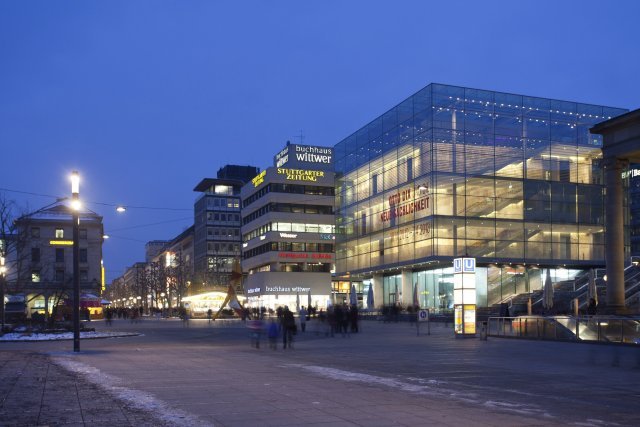
By USAG Stuttgart Public Affairs
Upon arrival in Stuttgart, shopping is one of the first things many newcomers either want to do or have to do as they get settled into their new home and surroundings. Shopping in Germany is usually a very modern affair, but there are some differences Americans should keep in mind so that it remains a positive experience for everyone.
Cash and carry!
Cash is still much more widely used in Germany than in the States. Small shops and restaurants often prefer customers to pay with cash, especially if the purchase is small. Most stores, especially large establishments or those found in a shopping mall, will readily accept credit and bank cards.
Many stores and restaurants will accept a German variant of a debit card, called a Girocard or EC (EuroCheque/Electronic Cash) card, even when they do not take credit. They are also frequently accepted at ticket machines and parking meters. EC cards are connected to a customer’s bank account and are secured with a chip and randomly-assigned PIN. They can be used across Europe and are available through a number of German banks as well as Service Credit Union on post. The credit union’s offering, called V-Pay, is available to members for a set-up fee of $25, with renewal every three years at $15.
Clothes
Just as weights and measurements for groceries are metric, clothing sizes in Germany are different from those in the U.S. It helps to know some of the different clothing size systems. There are applications for smartphones that can help with size conversion as well as online resources, though the size conversions can vary significantly from brand to brand and even within the same brand. While some clothing now comes with tags that list both U.S. and European sizes, it is important to be aware of the differences. Most clothing stores offer changing rooms, so the best practice is to always to try clothing on before purchasing it.
Customer Service
Customer service in Germany can be a bit gruffer than in the U.S., and be prepared for an attitude that the customer is not always right. Most large department stores will have return policies, but these policies may be more restrictive than those that Americans are familiar with. Any tags or labels should still be on the item and make sure to keep the receipt. Usually items needs to be returned within 14 days in order to get your money back.
Groceries
Large franchise grocery stores offer a full range of basic everyday grocery needs and can be found in any city or town. Shopping carts in Germany work on a simple coin deposit system. To take out a cart, simply deposit a 50 cent or 1 euro coin into the handle (some even take the U.S. quarter), which releases the cart. When you’ve finished, park it in the line of other carts and re-insert the metal plug to retrieve your coin.
 Although the product names, some packaging, and use of the metric measurement system is different, the stores in Germany are laid out in a way that will be familiar to you. Keep in mind that German grocery stores do not provide free bags at checkout. Customers typically bring their own reusable shopping bags, but if you should find yourself without, stores do offer inexpensive bags available for purchase, which can be found near the checkout. Be warned, when it’s your turn to check out, be ready to jump into action, as customers are expected to bag their own groceries.
Although the product names, some packaging, and use of the metric measurement system is different, the stores in Germany are laid out in a way that will be familiar to you. Keep in mind that German grocery stores do not provide free bags at checkout. Customers typically bring their own reusable shopping bags, but if you should find yourself without, stores do offer inexpensive bags available for purchase, which can be found near the checkout. Be warned, when it’s your turn to check out, be ready to jump into action, as customers are expected to bag their own groceries.
Malls
Sprawling shopping malls with dozens of shops, a food court and a movie theater like the kind that dot towns across America are still somewhat rare in Germany, though they can be found in larger cities. There are several large shopping centers through-out the Stuttgart area, including some as close as Sindelfingen and Böblingen; such as “Breuningerland” (nearby Panzer) “Mercaden” in Boeblingen, the “Stern Center” in Sindelfingen.
Downtown Stuttgart has the “Breuninger” mall, as well as the newly built “Milaneo” shopping mall. Most German cities have a Fussgänger (pedestrian zone), offering a shopping experience that more than makes up for the lack of malls. Think of them as large, open-air, cobble-stoned, mile-long shopping malls. Specialty stores, restaurants, and other services line these pedestrian streets, offering just about anything the average shopaholic might desire.
Shopping Hours
 Until quite recently, shopping hours in Germany were the most restrictive in Europe. Restrictions have eased since 2006, but newcomers may still chafe at the fact that most stores are closed by 20:00 during the week and are closed altogether on Sundays. Watch for a Verkaufsoffener Sonntag (shopping Sunday) when larger stores and malls have special opening hours. A handful of small convenience shops (usually located at train stations or in large city centers) are open on Sundays.
Until quite recently, shopping hours in Germany were the most restrictive in Europe. Restrictions have eased since 2006, but newcomers may still chafe at the fact that most stores are closed by 20:00 during the week and are closed altogether on Sundays. Watch for a Verkaufsoffener Sonntag (shopping Sunday) when larger stores and malls have special opening hours. A handful of small convenience shops (usually located at train stations or in large city centers) are open on Sundays.
